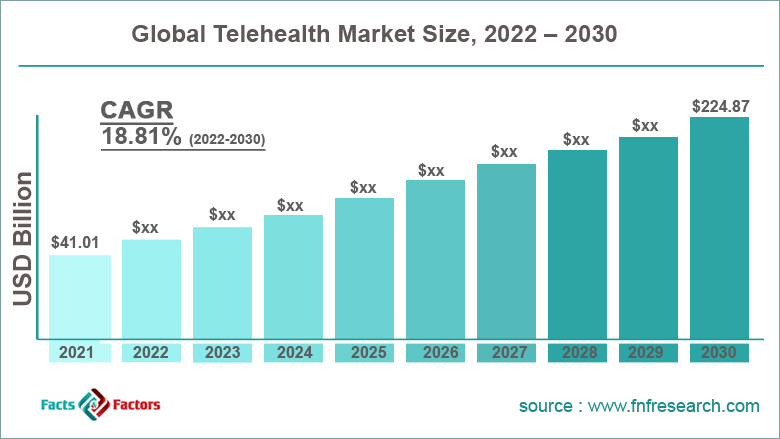Search Market Research Report
Telehealth Market Size, Share Global Analysis Report, 2022 – 2030

Telehealth Market Size, Share, Growth Analysis Report By Application (Patient Monitoring, Telemedicine, Medical Education, and Others), By End-Users (Homecare, Hospitals, and Others), By Mode of Delivery (On-Premise and Cloud-Based), By Product Type (Software, Hardware, and Services), and By Region - Global and Regional Industry Insights, Overview, Comprehensive Analysis, Trends, Statistical Research, Market Intelligence, Historical Data and Forecast 2022 – 2030
Industry Insights
[220+ Pages Report] According to the report published by Facts and Factors, the global telehealth market size was worth around USD 41.01 billion in 2021 and is predicted to grow to around USD 224.87 billion by 2030 with a compound annual growth rate (CAGR) of roughly 18.81% between 2022 and 2030. The report analyzes the global telehealth market drivers, restraints/challenges, and the effect they have on the demands during the projection period. In addition, the report explores emerging opportunities in the telehealth market.

 Market Overview
Market Overview
Telehealth refers to the process of distribution of healthcare or health-related services using telecommunication technologies or electronic information devices. Telehealth helps in delivering long-distance or remote contact between the patient and the physician. Healthcare using telehealth systems covers a broad range of medical care and includes medical education, reminders, care, monitoring, intervention, advice, and remote admissions. The scope of telehealth is extremely vast and continues to grow with time.
In the coming years, it is expected to cover almost all aspects of traditional medical care. Sometimes, telehealth and telemedicine are used as synonyms of one another; however, the Health Resources and Services Administration has mentioned that there is a key difference between the two. The former includes promotive, preventive, and curative medical care delivery whereas the latter describes only remote medical services like monitoring and diagnosis. Telehealth has a larger scope as compared to telemedicine and the global market has shown tremendous growth in the last 3 years driven by the pandemic.
 Key Insights
Key Insights
- As per the analysis shared by our research analyst, the global telehealth market is estimated to grow annually at a CAGR of around 18.81% over the forecast period (2022-2030)
- In terms of revenue, the global telehealth market size was valued at around USD 41.01 billion in 2021 and is projected to reach USD 224.87 billion, by 2030.
- The telehealth industry is projected to grow at a significant rate due to the growing internet and associated technology
- Based on application segmentation, telemedicine was predicted to show maximum market share in the year 2021
- Based on mode of delivery segmentation, cloud-based was the leading delivery mode in 2021
- On the basis of region, North America was the leading revenue generator in 2021

 Growth Drivers
Growth Drivers
- Growing internet and associated technology to drive market demand
The global telehealth market is projected to expand due to the growing internet technology along with associated devices and access to the internet. Telehealth majorly witnessed surging growth when the sector started leveraging the benefits of the internet. The arrival of high-speed internet connections further encouraged global market growth since speed is essential in medical care. Increased access to devices like smartphones, laptops, computers, and other portable devices helped in bringing telehealth to the homes of the people as well aided its promotion within the medical community.
When access to traditional healthcare becomes impossible due to various factors like the absence of healthcare facilities in remote areas, lack of mobility in patients, lack of transport, low funding, and lack of medical professionals to name a few, telehealth has proven to be extremely beneficial, especially during Covid-19, which is when it became one of the few measures through which doctors could cater to the needs of the patients.
 Restraints
Restraints
- Growing cases of healthcare fraud to restrict market expansion
With the growth in the telehealth industry, there has been a surge in the number of reported cases related to healthcare fraud which can take different forms ranging from problems due to false or inaccurate billing to more complex kickback scandals. The insurance schemes covering medical care are provided with a misrepresentation of the virtual services undertaken and this could lead to insurance fraud if the patient is incorrectly billed. In 2021, the Department of Justice, USA, laid federal charges on 138 medical professionals for healthcare-related malpractices including telehealth fraud.
 Opportunities
Opportunities
- Use of artificial intelligence to provide growth opportunities
The use of artificial intelligence (AI) and machine learning in telehealth care is expected to open more doors for tremendous growth during the projection period. AI-driven systems can provide doctors and medical professionals access to more data-driven information allowing them to make real-time decisions and provide overall improved patient care and experience. The global telehealth market is witnessing a surge in the number of research and innovation activities in the telehealthcare segment which is a positive sign toward future growth.
 Challenges
Challenges
- Lack of technical knowledge among patients to challenge the market expansion
In various incidences, the patient may not have the necessary technical skills to anchorage the benefits of telehealthcare and it is one of the key challenges that the telehealth industry players and medical professionals face. This is especially prevalent in remote areas that may not have the right education infrastructure. Hence it is recommended for companies to first survey the area and understand the skills level of the population before launching services. The market players may also have to invest in training the users with the right education programs to ensure that the programs can run successfully.
 Segmentation Analysis
Segmentation Analysis
The global telehealth market is segmented based on application, end-users, delivery, product type, and region
Based on application, the global market is segmented as patient monitoring, telemedicine, medical education, and others.
- In 2021, the global market was dominated by telemedicine and is expected to continue the growth trend during the forecast period. The segmental expansion is credited to the rapidly increased access to telemedicine during the pandemic further propelled by the rise in the number of players acting as service providers
- In 2021, more than 37% of the US adult population leveraged the benefits of telehealthcare as per the Centers for Disease Control and Prevention (CDC)
- Medical education and patient monitoring may also generate higher revenue with the former applying both to the care provider and the recipient
Based on end-users, the global market is divided into homecare, hospitals, and others. Based on product type, the global market is segmented into software, hardware, and services.
Based on mode of delivery, the global market is divided into on-premise and cloud-based
- The telehealth industry is projected to register the highest growth in the cloud-based mode of service delivery since it offers better advantages
- There has been significant growth in the number of operators providing cloud-based services to patients and the medical unit resulting in a rapid adoption rate
- Factors like ease of accessibility, seamless data storage, enhanced security, and high bandwidth are the major segmental propellers
- The average cost of using telehealthcare software can range between USD 30 to USD 300 depending on the features used
 Recent Developments:
Recent Developments:
- In June 2022, GoMeyra, a cloud-software service provider leading in innovative and real-time solutions, announced the launch of GoVirtual Clinic, a new telehealth clinic. The system is a cloud-based, single-interface solution that connects nurses, physicians, and labs to conduct medical tests and provide consulting services to the patients
- In July 2022, Neev Tech Labs, a Melbourne-based telehealth platform startup, launched Connect2MyDoctor. It is a 3-dimensional augmented reality module to be used for patient education. The technology is currently being used in 15 countries and has a database of more than 3000 specialists
 Report Scope
Report Scope
Report Attribute |
Details |
Market Size in 2021 |
USD 41.01 Billion |
Projected Market Size in 2030 |
USD 224.87 Billion |
CAGR Growth Rate |
18.81% CAGR |
Base Year |
2021 |
Forecast Years |
2022-2030 |
Key Market Players |
GE Healthcare, Teladoc Health Inc., Medtronic, Koninklijke Philips N. V, Global Med, Cerner Corporation, MD Live, Siemens Healthineers, Doctor On Demand, American Well., and Others |
Key Segment |
By Application, End-Users, Mode of Delivery, Product Type, and Region |
Major Regions Covered |
North America, Europe, Asia Pacific, Latin America, and the Middle East &, Africa |
Purchase Options |
Request customized purchase options to meet your research needs. Explore purchase options |
 Regional Analysis
Regional Analysis
- North America to witness surging growth during the projection period
The global telehealth market is projected to register the highest growth in North America which dominated around 43% of the global market share in 2021. Factors like high and growing expenditure on regional healthcare infrastructure, presence of gaming-changing information technology (IT) service providers, and higher access to fast-speed internet along with supporting devices like computers, smartphones, smartwatches, and others are the main reasons propelling the growth in North America.
Furthermore, higher awareness amongst the population about the benefits of telehealth along with a growing adoption rate amongst medical professionals encouraging more patients to adopt the systems and technologies could lead to growth in CAGR in the coming years. A large number of dominant players are housed in North America, especially in the US. These companies have a consumer database that is spread across continents and is registering consistent growth with time additionally encouraged by the rise in the number of start-ups looking to grab the opportunities that the global market holds.
 Competitive Analysis
Competitive Analysis
- GE Healthcare
- Teladoc Health Inc.
- Medtronic
- Koninklijke Philips N. V
- Global Med
- Cerner Corporation
- MD Live
- Siemens Healthineers
- Doctor On Demand
- American Well
The global telehealth market is segmented as follows:
 By Application Segment Analysis
By Application Segment Analysis
- Patient Monitoring
- Telemedicine
- Medical Education
- Others
 By End-Users Segment Analysis
By End-Users Segment Analysis
- Homecare
- Hospitals
- Others
 By Mode of Delivery Segment Analysis
By Mode of Delivery Segment Analysis
- On-Premise
- Cloud-Based
 By Product Type Segment Analysis
By Product Type Segment Analysis
- Software
- Hardware
- Services
 By Regional Segment Analysis
By Regional Segment Analysis
- North America
- The U.S.
- Canada
- Mexico
- Europe
- France
- The UK
- Spain
- Germany
- Italy
- Nordic Countries
- Denmark
- Sweden
- Norway
- Benelux Union
- Belgium
- The Netherlands
- Luxembourg
- Rest of Europe
- Asia Pacific
- China
- Japan
- India
- Australia
- South Korea
- Southeast Asia
- Indonesia
- Thailand
- Malaysia
- Singapore
- Rest of Southeast Asia
- Rest of Asia Pacific
- The Middle East & Africa
- Saudi Arabia
- UAE
- Egypt
- South Africa
- Rest of the Middle East & Africa
- Latin America
- Brazil
- Argentina
- Rest of Latin America
Industry Major Market Players
- GE Healthcare
- Teladoc Health Inc.
- Medtronic
- Koninklijke Philips N. V
- Global Med
- Cerner Corporation
- MD Live
- Siemens Healthineers
- Doctor On Demand
- American Well
Frequently Asked Questions

Copyright © 2025 - 2026, All Rights Reserved, Facts and Factors


